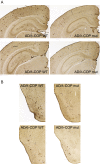Relevance of the COPI complex for Alzheimer's disease progression in vivo
- PMID: 27114526
- PMCID: PMC4868486
- DOI: 10.1073/pnas.1604176113
Relevance of the COPI complex for Alzheimer's disease progression in vivo
Abstract
Cellular trafficking and recycling machineries belonging to late secretory compartments have been associated with increased Alzheimer's disease (AD) risk. We have shown that coat protein complex I (COPI)-dependent trafficking, an early step in Golgi-to-endoplasmic reticulum retrograde transport, affects amyloid precursor protein subcellular localization, cell-surface expression, as well as its metabolism. We present here a set of experiments demonstrating that, by targeting subunit δ-COP function, the moderation of the COPI-dependent trafficking in vivo leads to a significant decrease in amyloid plaques in the cortex and hippocampus of neurological 17 mice crossed with the 2xTg AD mouse model. Remarkably, an improvement of the memory impairments was also observed. Importantly, human genetic association studies of different AD cohorts led to the identification of 12 SNPs and 24 mutations located in COPI genes linked to an increased AD risk. These findings further demonstrate in vivo the importance of early trafficking steps in AD pathogenesis and open new clinical perspectives.
Keywords: Alzheimer; COPI; EWAS studies; GWAS studies; human genetic.
Conflict of interest statement
The authors declare no conflict of interest.
Figures






References
Publication types
MeSH terms
Substances
Grants and funding
LinkOut - more resources
Full Text Sources
Other Literature Sources
Medical
Molecular Biology Databases

